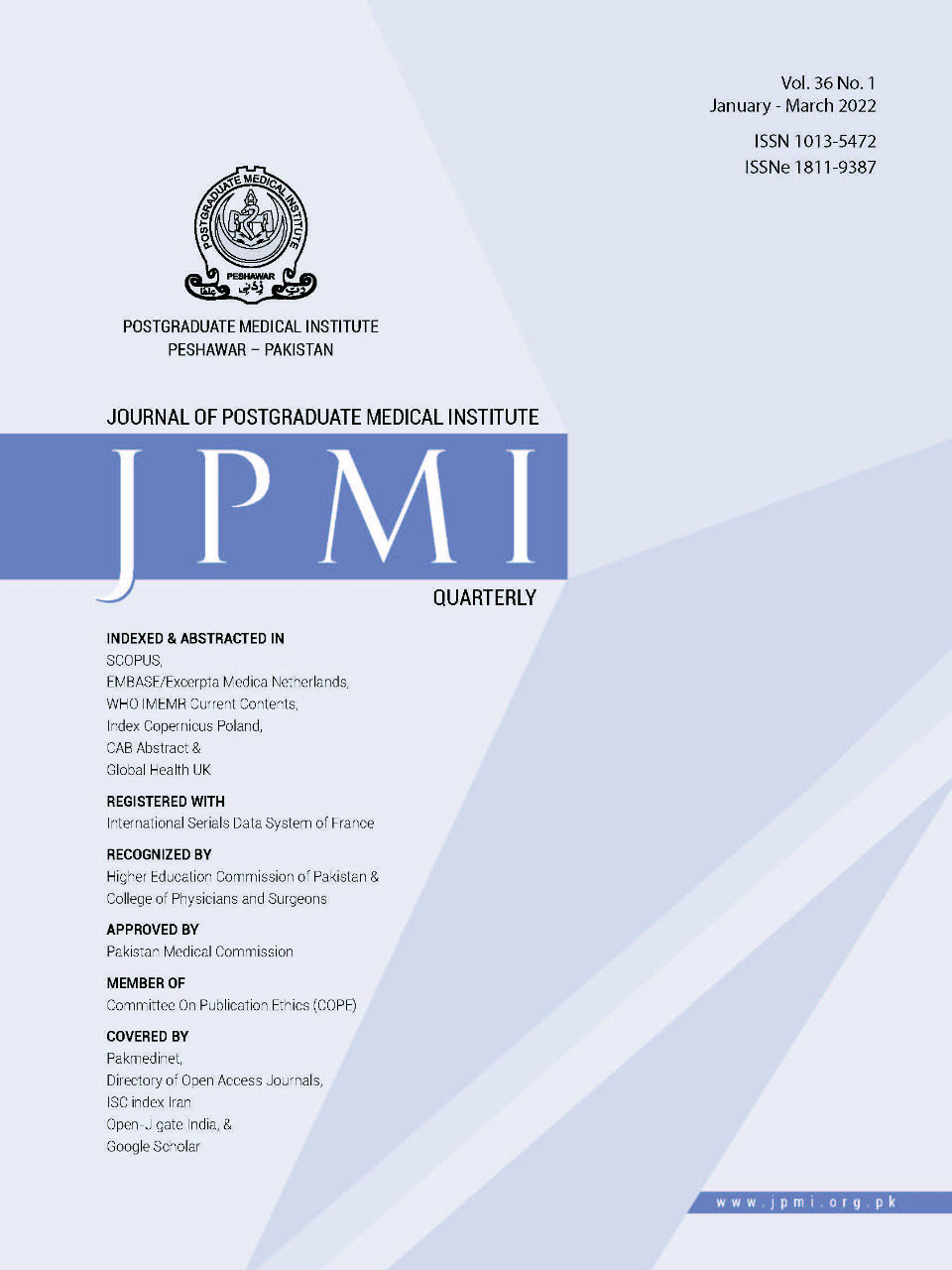ASSOCIATION OF SCAR TENDERNESS AND OTHER CLINICAL SIGNS WITH SCAR COMPLICATIONS IN PATIENTS UNDERGOING THE TRIAL OF LABOR AFTER CESAREAN SECTION
Main Article Content
Abstract
Objective: To determine association between scar tenderness and other clinical signs of scar complications in patients undergoing a trial of labor after cesarean section.
Methodology: This case-control study was conducted in the Department of Obstetrics and Gynaecology, Lady Reading Hospital, Peshawar from June 2017 to June 2019. Patients with scar complications at repeat emergency cesarean section, after a failed trial of labor, were taken as cases. Controls were patients, who were found to have intact scars at repeating emergency cesarean delivery after trial of labor. Cases were compared with controls for the presence of scar tenderness, maternal tachycardia, and Cardiotocography (CTG) abnormalities. Data were analyzed using SPSS Version 23.0.
Results: Sixty-six women were enrolled, with an age range of 21-40 years with a mean age of 27±43.42 years for cases, and 28.66±4.85 for controls. The association of scar tenderness alone (p=0.2), maternal unexplained tachycardia alone (p=0.886), and abnormal CTG alone (p=0.44) with scar complications were not significant. A significant association was observed between a combination of scar tenderness, abnormal CTG, and maternal tachycardia with scar complications (p=0.006, aOR=21.33, CI:2.37-19.20).
Conclusion: A combination of clinical signs including scar tenderness and unexplained maternal tachycardia as well as abnormal CTG serve as a valid indicator of impending scar complications and should be included in the monitoring of women undergoing the trial of labor after a previous cesarean.
Article Details
Work published in JPMI is licensed under a
Creative Commons Attribution-NonCommercial 2.0 Generic License.
Authors are permitted and encouraged to post their work online (e.g., in institutional repositories or on their website) prior to and during the submission process, as it can lead to productive exchanges, as well as earlier and greater citation of published work.
References
Fagerberg MC, Maršál K, Källén K. Predicting the chance of vaginal delivery after one cesarean section: validation and elaboration of a published prediction model. Eur J Obstet Gynecol Reprod Biol. 2015;188:88-94. DOI: 10.1016/j.ejogrb.2015.02.031.
Chaillet N, Dumont A, Abrahamowicz M, Pasquier JC, Audibert F, Monnier P, et al. A cluster-randomized trial to reduce cesarean delivery rates in Quebec. New England Journal of Medicine. 2015 ;372(18):1710-21. DOI: N Engl J Med 2015 Apr 30;372(18):1710-21. DOI: 10.1056/NEJMoa1407120.
Hendler I, Bujold E. Effect of prior vaginal delivery or prior vaginal birth after cesarean delivery on obstetric outcomes in women undergoing a trial of labor. Obstet Gynecol. 2004; 104: 273-77. DOI: 10.1097/01.AOG.0000134784.09455.21.
Mansoor M, Kashif S, Tariq R. To evaluate factors for a successful outcome in VBAC. Pak J Med Health Sci 2010; 4: 322-25
Gaikwad HS, Aggarwal P, Bannerjee A, Gutgutia I, Bajaj B. Is scar tenderness a reliable sign of scar complications in labor? nt J Reprod Contracept Obstet. 2012;1:33-6. DOI: 10.5455/2320-1770.
Jastrow N, Demers S, Chaillet N, Girard M, Gauthier RJ, Pasquier JC, et al. Lower uterine segment thickness to prevent uterine rupture and adverse perinatal outcomes: a multicenter prospective study. Am J Obstet Gynecol. 2016;215(5):604.e1-6. DOI: 10.1016/j.ajog.2016.06.018.
Gupta JK, Smith GCS, Chodankar RR.Birth after previous cesarean birth. Green-top guideline No.45. Oct 2015:1-33
Capogna, G.Analgesia for Induced Labor and for Vaginal Birth After Cesarean Section. In: Capogna, G. (eds). Springer Cham;2015. DOI: 10.1007/978-3-319-13890-9_13
Vlemminx MW, de Lau H, Oei SG. Tocogram characteristics of uterine rupture: a systematic review. Arch Gynecol Obstet. 2017;295(1):17-26. DOI: 10.1007/s00404-016-4214-7.
Khalil S, Shaheen N, Iftikhar M P.Clinical significance of uterine scar tenderness in predicting strength of scar in ladies with previous lower segment cesarean section. Rawal Medical Journal.2013;38(04):401-3.
Anderson MM,Thisted DLA,Amir Wahlin I,Krebs L.Can Intrapartum Cardiotocography Predict Uterine Rupture among Women with Prior Caesarean Delivery? A Population Based Case-Control Study.PLoS One.2016; 11(2): e0146347. DOI: 10.1371/journal.pone.0146347.
Ashraf M, Waris N. Frequency of Uterine Scar Dehiscence in Patients of Previous One C-Section Having Scar Tenderness. Pakistan Journal of Medical Health Sciences. 2016 Apr 1;10(2):638-40.
Desseauve D,Grenouilleau BM, Fritel X, Lathelize J,Sarreau M, Pierre F. Feral heart rate abnormalities associated with uterine rupture:a case control study:A new time-lapse approach using a standardized classification. Eur J Obstet Gynecol Reprod Biol. 2016;197:16-21.
Bartolo S,Goffinet F,Blondel B,Tharaux DC.Why women with previous caesarean and eligible for a trial of labour have an elective repeat caesarean delivery? A national study in France. BJOG. 2016 Sep;123(10):1664-73. DOI: 10.1111/1471-0528.14056.
Tasleem H,Ghazanfar H. Trial of labor after previous cesarean delivery (TOLAC) and association of BMI and previous vaginal delivery with frequency of VBAC. Bangladesh J Med Sci. 2016;15(4), 546-55. DOI: 10.3329/bjms.v15i4.21687
Sentilhes L,Vayssiere C,Beucher G,Tharaux CD,Deruelle P,Diemunsch P et al. Delivery for women with a previous cesarean: guidelines for clinical practice from the French College of Gynaecologists and Obstetricians(CNGOF). Eur J Obstet Gynecol Reprod Biol.2013;170 (1):25-32. DOI: 10.1016/j.ejogrb.2013.05.015.


